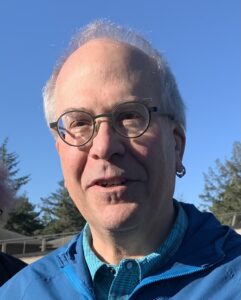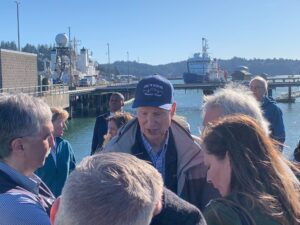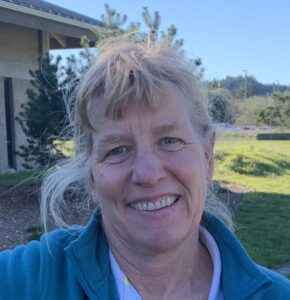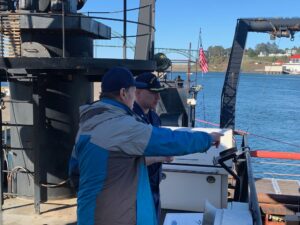
By GARRET JAROS/YachatsNews
NEWPORT – Sen. Ron Wyden, D-Ore. listened to presentations by National Oceanic and Atmospheric Administration research biologists and toured one of its research vessels Saturday at the Hatfield Marine Science Center.
The one-hour stop was a show of support organized by various Newport and Lincoln County officials as they begin a campaign to keep Newport as the homeport for NOAA’s Pacific fleet. Wyden’s visit preceded town hall meetings later in the day in Lincoln City and Tillamook. The tour was billed as an overview of the center along with updates on NOAA fisheries and marine operations and the role each plays in the Oregon coast’s economy.
With Wyden’s help, Newport beat out three Puget Sound cities in 2011 to become the homeport for two NOAA ships on the West Coast. The homeport also provides logistical, engineering, electronics, maintenance and administrative support to all the ships in the agency’s Pacific fleet, which can include half a dozen vessels including deep sea research ships and nearshore scientific craft.
The agency signed a 20-year lease that is set to expire in 2031. NOAA has started evaluating its needs for its Pacific fleet and officials on the central Oregon coast are beginning to work to stress the importance of NOAA’s presence in Newport, especially its working relationship with scientists at the Hatfield center.
Wyden was greeted by Mark Farley, the associate director of the center, who gave an overview of operations at the center before turning it over to NOAA research fisheries biologists Chris Jordan and Laurie Weitkamp who talked about integrating scientific research into management decisions.
Jordan talked about the importance of salmon to Northwest communities and fisheries and the role science plays in transformative action for salmon recovery.

“How do we take that information within science and translate it into management for those communities?” Jordan said. “Because it is going to be community action that makes the transformative difference but it is going to be guided by science and we wanted to give you an example of that by talking about some of the science that is done here on the ocean.”
Jordan used the example of science-guided habitat restoration in learning how floodplains, which benefit both salmon and agriculture, are connected with forest management decisions that affect rivers and streams. And how those science-guided practices can be integrated to support a resilient and sustainable fishery.
“Similarly with fishing communities,” Jordan said. “How can we have sustainable fisheries? And we get that from resilient robust populations and we don’t have those right now. How are we taking our science and turning that into results? That’s the transformation. And that’s science led — but it’s community actions.”

“What I like so much is you talk about good science one way or another in practically every sentence,” Wyden said. “And the reality is, Washington D.C. isn’t doing a lot of good science. There’s a bunch of big battles on women’s health and the issue is are you going to use science or politics?”
The science sometimes gets lost in the messaging because it is complicated, Jordan said. But it is learning how all the systems integrate to support things like salmon recovery and then implementing them that is crucial. It is taking all the knowledge generated in a place like the Hatfield center – “across all these agencies, how do we take that and put it in the hands of the fishing communities … the managers of the fishery, how do we put that in the hands of the managers who plan for water?
“Oregon is out of water,” Jordan said. “We are in a rainforest state, and … statewide we’re at the edge. And that effects people but it also effects salmon.”
Weitkamp highlighted some of the ways NOAA is working on the ocean to help sustain fisheries.

“I’ve heard it said that counting fish is just like counting trees, except you can’t see them and they move,” Weitkamp said. “And that’s what we have with this ocean.”
NOAA runs three programs out of Newport, she said. The first is a survey of groundfish like lingcod and rockfish that runs the length of the West Coast from Canada to Mexico in order to assess fishing limits for those species. The second is a hake survey. The hake fishery is the single largest fishery on the West Coast. And the third is an observer program that places scientists on commercial fishing boats to monitor the catch, especially the bycatch.
“Congress really likes that program because it’s a chance to get some local people, some scientists, some companies, kind of getting the whole package together,” Wyden said to Weitkamp. “Do you have enough funding for it? Keep me posted on that because dollar for dollar that observer program is a real winner.”
Weitkamp finished her presentation by talking about a unique NOAA study called the Newport Line that consists of a series of monitoring stations that extend 200 miles offshore that sample the ocean for different indicators of change.
“By keeping a pulse on the ecosystem here we are working with fishermen and in cooperative projects to really understand what is going on …” Weitkamp said. “It’s a really important part of translating the science into management.”

Wyden finished his visit aboard NOAA’s Bell M. Shimada, a 209-foot fisheries research ship docked at the center. He met the officers in charge of the ship as well as NOAA ocean operations.
Wyden did not give any statements during the tour but stopped to give a word to YachatsNews before departing.
“This is so important to Oregon,” Wyden said. “We do a lot of things well. One of the things we do best, is we show that we can make sure that on the water you can have national security, you can have fish, you can have science, you can have community. And I just want to make sure that we keep this way of life.
“I want our kids and our grandkids to be able to be part of it and that’s why I came out this morning to learn a bit about it,” he continued. “A lot of these fights are tough. We have the (NOAA) home port now. We got it because we won it on the merits. We just keep trying to show Newport is tops. When you set aside the politics – democrats and republicans, we can outcompete anybody. We’re Oregon. It’s the Oregon way.”
- Garret Jaros is YachatsNews’ full-time reporter and can be reached at GJaros@YachatsNews.com



Didn’t NOAA cite air travel to Newport as a concern in deciding what to do with the homeport?
If anyone needs an example of why they should support YachatsNews financially and drop their subscription to the awful Lincoln Leader, this is it. This story focuses on the purpose of Wyden’s visit and what happened. The Brand X newspaper spent half of its story focusing on the extremist right-wing (and incorrect) views of a handful of protesters outside the meeting. Bad news judgment and bad reporting.
Really good article. Very thorough. We need to keep NOAA.
I’m wondering how watershed health science from OSU is integrated into NOAA’s research focused mainly in the oceans. I think this is important because it takes into account the total life cycle of salmon in particular. All of Lincoln County’s rivers are victims of dangerous herbicides like glyphosate and 2,4-D, thanks to their approved use for the timber industry on clear cuts down to these rivers watersheds and banks. Updated research around these herbicides needs to be included in a serious re-examination of current timber policies and the harmful health effects these herbicides have on humans, livestock, forests and wildlife. Micro plastic pollution in the oceans is another troubling aspect that I didn’t see covered in this visit by Senator Wyden. Here’s a link to a great podcast on the dangers of microplastics in our food and bodies. https://tucradio.org/podcasts/newest-podcasts/matt-simon-microplastics-everywhere-in-water-land-and-air/
Very good points, I’d like to know that as well.